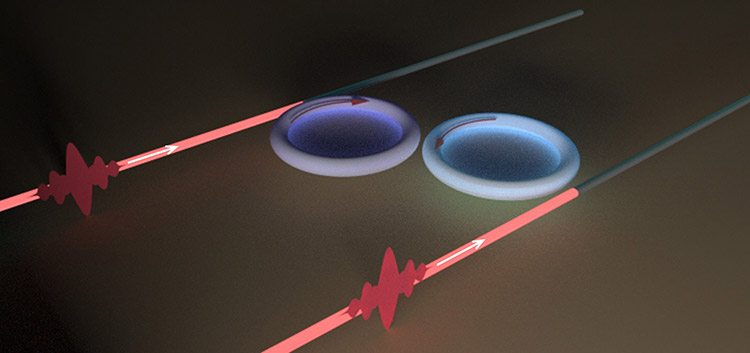
Researchers Engineer Optical Losses to Perfect Absorption

Researchers created two WGM microresonators with different absorption losses and coupled their optical fields by setting them close together. Each resonator is coupled to a fiber waveguide. By changing the gap between the resonators and waveguides, they were able to tune the coupling loss. Courtesy of Washington University in St. Louis/Lan Yang.
Research conducted by a team from Washington University in St. Louis, in collaboration with A. Douglas Stone of Yale University, has uncovered new approaches to manipulating light absorption in optical resonators by different types of optical losses. The team achieved a degeneracy of two coherent perfect absorbing modes, which leads to unconventionally broadened absorption spectrum, as well as the capability to switch between weak and strong absorption over a broad frequency band.
The team, led by Lan Yang, the Edwin H. & Florence G. Skinner Professor in Electrical & Systems Engineering in the McKelvey School of Engineering at Washington University in St. Louis, used whispering-gallery mode (WGM) resonators, which only allow light with certain frequencies to remain within the system. As a result of material absorption loss, the light can be absorbed by the resonator.
Further, a fiber waveguide is usually placed tangential to the rim of the resonator for coupling light into or out of the resonator. The coupling between the resonator and the fiber creates an additional nondissipative coupling loss channel that allows the light trapped inside the resonator to escape from the fiber.
The researchers created two WGM microresonators with different absorption losses and coupled their optical fields by setting them close together. Each resonator is coupled to a fiber waveguide. By altering the gap between the resonators and waveguides, the team was able to tune the coupling loss.
In the experiment, the team achieved a perfect absorption of incoming light from the waveguide channels, a phenomenon called coherent perfect absorption (CPA), by optimizing the ratio between the two coupling losses and the two absorption losses. CPA is the “time reversal” of the lasing process — rather than emitting light, the system fully absorbs the illuminated light without any emission or out-scattering.
“In general, a lossy optical system is able to absorb incoming light, but perfect absorption cannot occur unless the loss parameters, such as the ratio between absorption and coupling losses, is judiciously designed and controlled,” Yang said.
“For perfect absorption to happen, the incoming laser beams have to oscillate at an exact frequency and be injected from two waveguide channels with a well-designed ratio of amplitudes and phases.”
A system with two optical resonators has two types of waveforms that can be fully absorbed, and they happen at two different frequencies. Therefore, the system usually behaves as two perfect absorbers. But with an optimization of the coupling between the resonators tuned by their gap, those two frequencies and waveforms merge.
By tuning the system to that point, the researchers observed for the first time a line shape of the output spectrum that is broader than the conventional Lorentzian line shape.
“When two CPA modes coalesce, the system reaches a special kind of degeneracy which is referred to as a perfectly absorbing exceptional point,” said Changqing Wang, a doctoral student in Yang’s lab and first author on the paper. “It is fundamentally different from other conventional types of degeneracies that were found in open wave systems. It seems like you have two absorbers which operate at the same frequency and perfectly absorb the same type of beam. But the system behaves much differently from a single absorber, nor simply the sum of two absorbers.”
With the degenerate perfect absorbing modes, by slightly changing the relative delay of the two laser beams that enter the waveguides, the absorption of the system can vary dramatically from strong to weak.
Compared to conventional absorbers, this modulation occurs at a broader frequency range because of the effect of nontrivial degeneracy at the perfectly absorbing exceptional point. This phenomenon does not occur for a system without loss or for systems that have a balance of gain and loss.
“This work brings new insight to how to exploit different kinds of losses to manipulate an open physical system,” Yang said. “In the past, loss has enabled a great many interesting physical phenomena in non-Hermitian optical, acoustic, and electronic systems, but there is great potential in leveraging the different roles of different sources of loss. For example, here in this work the material absorption loss plays a distinct role from the nondissipative coupling loss in tailoring the scattering property of the system. The various types of losses enrich the degrees of freedom for optical engineering.”
The research was published in Science (www.doi.org/10.1126/science.abj1028).
Published: September 2021